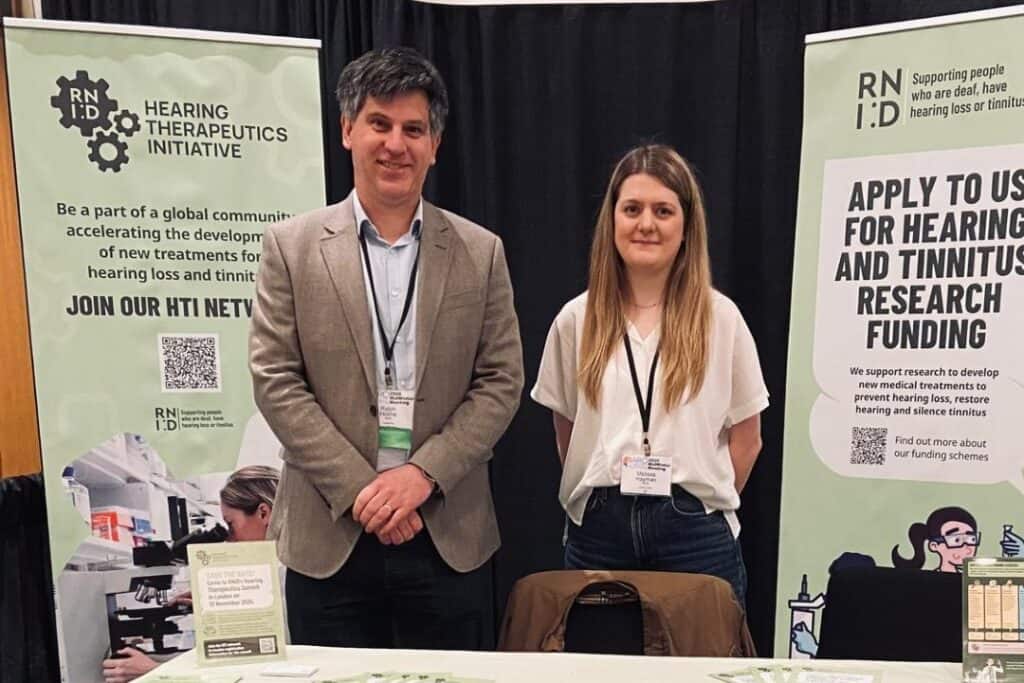Last week Dr Ralph Holme, our Director of Research, and Dr Melissa Hayman, our Hearing Therapeutics Manager, joined researchers from around the world for the Association for Research in Otolaryngology (ARO) annual MidWinter meeting.

With more than 300 oral and 800 poster presentations over five days, it is the largest international conference focused on hearing research.
Here Ralph shares just some of the exciting highlights from the conference.
Hearing aids are getting smarter
Professor Brian Moore opened the meeting discussing the benefits of hearing aids, and how they could be improved.
The ability to directly connect hearing aids to a sound source (e.g. phone, remote mic, TV etc.) brings huge benefits, but he described how there is still scope to improve how they process high frequency sounds and reducing unwanted noise.
Hearing aids are typically programmed based on a person’s hearing test to guide which sounds to amplify. At the conference, we heard about the latest research which is exploring alternative approaches based on using machine learning to optimise hearing aid settings to provide better quality hearing. A big challenge people using hearing aids can face is listening to a speaker when there is a lot of background noise.
An interesting approach being explored to overcome this is using signals from the brain to focus the hearing aid on the sounds the person is paying most attention to.
There are still challenges to be addressed with this though, such as they require a lot of computational processing which must be done very quickly to avoid the speech getting out of sync with the visual cues, and they also require a lot of battery power.
Gene therapy successes
Over a year ago, we saw the first reports that gene therapy had been successfully used to restore hearing in a child with deafness caused by a faulty version of the otoferlin gene.
Eleven children have now been treated in Regeneron’s Chord clinical trial and their hearing assessed. Ten of these children show notable improvements in hearing with some having their hearing restored to normal levels.
Encouragingly, results in a separate preclinical study showed that the gene therapy restores many of the auditory features in the brain that you would expect to see with normal hearing, suggesting that the quality of hearing this particular gene therapy can provide could be significantly better than would be experienced via a hearing aid or cochlear implant.
Whilst the otoferlin results are spectacular, otoferlin-deafness is very rare. It was exciting to see the progress being made towards a second gene therapy targeting GJB2 the most common form of inherited deafness. The therapy has been shown to restore hearing in mice and importantly can be targeted to the correct cells within the cochlea – expect clinical trials to start as soon as next year.
Treatments for age-related hearing loss
Most people with hearing loss acquire it as they get older and there are currently no treatments able to prevent its onset or reverse it.
Age-related hearing loss can be the result of damage to any one of a number of cell types within the cochlea, but we currently lack the precision diagnostics needed to identify the precise cause of a person’s hearing loss – which is important if we want to provide the right treatment to the right person.
By studying mice with known pathology, researchers from King’s College London presented research showing that they have found a way of identifying one of the pathologies associated with age-related hearing loss based on an analysis of the auditory brainstem response. This is a hearing test that is routinely carried out by audiologists and so there is a good chance that the approach could also be used in people too.
Progress is also being made, using a range of cutting-edge genetic and molecular approaches, to identifying biological processes underlying age-related hearing loss – the first step towards developing treatments.
Some of the treatments that are likely to emerge in the future are focused on enhancing residual hearing or regenerating lost or damaged cells within the cochlear. Others are focused on stopping the degeneration of cells and processes important for hearing.
Making connections
At our exhibition booth we spoke to researchers about how we can support their research via our grant schemes.

I was proud to see many of our current grant holders presented their RNID-funded research, acknowledging our vital support.
I left the meeting feeling really inspired – not only by the groundbreaking science, but also the brilliant researchers who are so focused on finding treatments for hearing loss and tinnitus.
Find out more about applying for research funding.